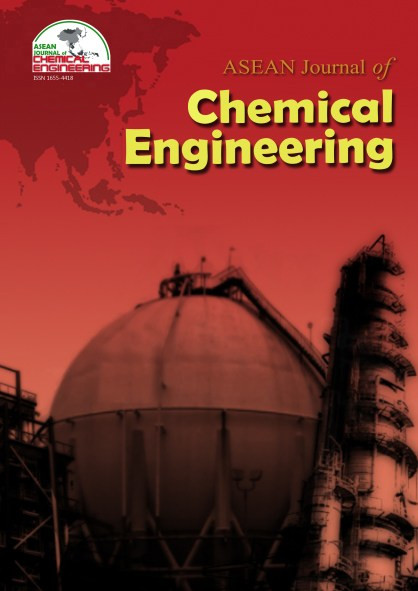Industrial Application of Rice Husk as an Alternative Fuel in Cement Production for CO2 Reduction
Abstract
The cement industry generally spends about 30-40% of production costs to provide energy for production. It forces the cement industry to look for cheaper and widely available alternative energy sources to increase its competitiveness. The dominance of fossil fuels poses another problem for the cement industry in the form of high CO2 emissions. To overcome this, PT Indocement Tunggal Prakarsa (ITP) Tbk, Palimanan Unit, is committed to continuously looking for alternative energy sources by utilizing rice husks in the suspension preheater unit. This study aims to evaluate the performance, especially the reduction of CO2 emissions and the economic benefits of energy substitution applications using rice husks. Based on the calculation in 2020, there will be an increase of 37% in 2021, and the total energy of rice husks will reach around 1,996,671 GJ. It is equivalent to using fossil fuel coal of approximately 106,450 tonnes. The contribution of rice husks to primary energy consumption seems to continue to increase yearly. A significant increase occurred between 2020 - 2021, and the contribution of rice husks reached 23%. Rice husks usage has reduced CO2 emissions by almost 220,000 tons of CO2e and brought production cost benefits to around 40 billion by 2021. Therefore, the substitution of coal fuel using rice husk has proven to be effective in reducing CO2 emissions in the cement production process. By still paying attention to the reliability of the process and the quality of the cement products produced, these efforts can be continuously encouraged to realize cement products that are more environmentally friendly.
References
Alit, I. B., Susana, I. G. B., & Mara, I. M., 2020. “Utilization of rice husk biomass in the conventional corn dryer based on the heat exchanger pipes diameter”. Case Studies in Thermal Engineering, 22, 100764.
Ariyaratne WKH., 2009. “Alternative fuels in cement kilns – characterization and experiments”, MSc. Thesis, Telemark University College, Norway.
Benhelal, E., Shamsaei, E., & Rashid, M. I., 2021. “Challenges against CO2 abatement strategies in cement industry: A review”. Journal of Environmental Sciences, 104, 84-101
Chatziaras, N., Psomopoulos, C. S., & Themelis, N. J., 2014. “Use of alternative fuels in cement industry”. In Proceedings of the 12th International Conference on Protection and Restoration of the Environment, Vol. 1, 521-529
Corti, A., & Lombardi, L., 2004. “End life tyres: Alternative final disposal processes compared by LCA”. Energy, 29(12-15), 2089-2108.
Garg, A., Smith, R., Hill, D., Longhurst, P. J., Pollard, S. J. T., & Simms, N. J., 2009. “An integrated appraisal of energy recovery options in the United Kingdom using solid recovered fuel derived from municipal solid waste”. Waste Management, 29(8), 2289-2297.
Kumar, S., Sangwan, P., Dhankhar, R. M. V., & Bidra, S., 2013. “Utilization of rice husk and their ash: A review”. Res. J. Chem. Env. Sci, 1(5), 126-129.
Le, A., Sharifi, V. N., & Swithenbank, J., 2007. “System approach from biomass combustion in packed bed reactor,” ASEAN Journal of Chemical Engineering, 7(1 & 2), 16-29
Panjaitan, T. W., Dargusch, P., Wadley, D., & Aziz, A. A., 2020. “Toward the best practice emissions reduction in an emerging economy: an analysis of cement manufacturing in Indonesia,” Entrepreneurship and Sustainability Issues, 8(1), 103.
Panjaitan, T. W., Dargusch, P., Wadley, D., & Aziz, A. A., 2021. “Meeting international standards of cleaner production in developing countries: Challenges and financial realities facing the Indonesian cement industry,” Journal of Cleaner Production, 318, 128604.
Purvis, M. R., Lim, G., Races, S. A., Salazar, C. M., Tan, R. G. R., & Santos, S., 2004, “Modelling as an Aid to Biomass Combustion in Plant Design,” ASEAN Journal of Chemical Engineering, 4(2), 75-83.
Radenahmad, N., Reza, M. S., Bakar, M. S. A., & Azad, A. K., 2020. “Thermochemical characterization of rice husk (Oryza sativa Linn) for power generation,” ASEAN Journal of Chemical Engineering, 20(2), 184-195.
Rahman, A., Rasul, M. G., Khan, M. M. K., & Sharma, S., 2015. “Recent development on the uses of alternative fuels in cement manufacturing process,” Fuel, 145, 84-99.
Usón, A. A., López-Sabirón, A. M., Ferreira, G., & Sastresa, E. L., 2013. “Uses of alternative fuels and raw materials in the cement industry as sustainable waste management options,” Renewable and Sustainable Energy Reviews, 23, 242-260.
World Steel Association., 2020. “Steel's contribution to a low carbon future and climate resilient societies,” ISBN 978-2-930069-83-8
Worrell, E., Price, L., Martin, N., Hendriks, C., & Meida, L. O., 2001. “Carbon dioxide emissions from the global cement industry,” Annual review of energy and the environment, 26(1), 303-329.
Copyright holder for articles is ASEAN Journal of Chemical Engineering. Articles published in ASEAN J. Chem. Eng. are distributed under a Creative Commons Attribution-NonCommercial 4.0 International (CC BY-NC 4.0) license.
Authors agree to transfer all copyright rights in and to the above work to the ASEAN Journal of Chemical Engineering Editorial Board so that the Editorial Board shall have the right to publish the work for non-profit use in any media or form. In return, authors retain: (1) all proprietary rights other than copyright; (2) re-use of all or part of the above paper in their other work; (3) right to reproduce or authorize others to reproduce the above paper for authors’ personal use or for company use if the source and the journal copyright notice is indicated, and if the reproduction is not made for the purpose of sale.



